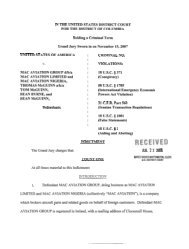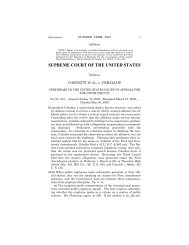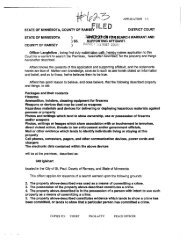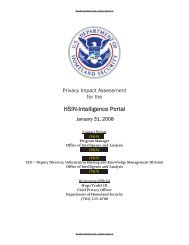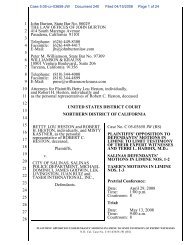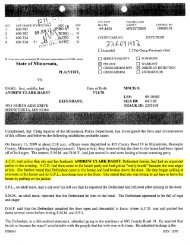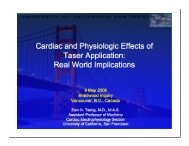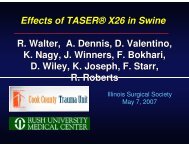TASER Electronic Control Devices Review Of Safety Literature
TASER Electronic Control Devices Review Of Safety Literature
TASER Electronic Control Devices Review Of Safety Literature
Create successful ePaper yourself
Turn your PDF publications into a flip-book with our unique Google optimized e-Paper software.
Sharp pain, temperature, crude touch (τ about 650 µs)<br />
III A-δ myelinated fibers<br />
About 3 microns (1-5 microns) diameter<br />
About 40 V/m threshold (24-120 V/m)<br />
Perceptions of pain, discomfort, and sensation overload are carried not only by<br />
the myelinated axons as described above (type III A- δ fibers) but also by small,<br />
nonmyelinated type IV C axons. These are the cells thought to be responsible for<br />
dull, aching diffuse pain (as opposed to the sharper pain carried by type III fibers).<br />
From the work of Li and Bak 10 it can be estimated that C fibers have stimulation<br />
thresholds about 20 times higher than those of sensory A fibers. Specifically:<br />
Dull, diffuse pain; post-ganglionic autonomic fibers (τ about 500-600 µs;<br />
estimated from Li and Bak) 10<br />
IV C unmyelinated fibers<br />
About 0.5-2 microns diameter<br />
Thresholds of about 500 V/m or higher.<br />
Cardiac vs. Muscle Stimulation<br />
By comparison to motor or sensory myelinated nerves, the heart’s excitability (as<br />
in pacing of the heart) is relatively low for brief stimuli. This is because, despite<br />
the fact that the minimum (rheobase) level of stimulus needed for long duration<br />
pulses is probably similar between cardiac cells and myelinated nerves 8 cardiac<br />
strength-duration time constants are about 2-3 ms or higher (i.e. at least 10-20<br />
times higher than the A- α motor neuron fibers which control skeletal muscle contraction).<br />
The heart is also located deep within the torso (as opposed to the<br />
skeletal muscle which comprises much of the superficial layers of the torso and<br />
into which electrical weapon probes may penetrate if they embed just below the<br />
skin). Thus, relatively little, if any, current will pass through the heart. This effect<br />
of relatively low penetration into the heart given surface or near-surface stimulation<br />
of tissues is well known and well studied both in the electrical safety literature<br />
as well as the medical literature of transthoracic pacing and defibrillation.<br />
After Effects<br />
Muscles immediately relax after the nerve signals are released. This is most<br />
clearly demonstrated by the numerous videos of ECD-exposure volunteers getting<br />
up immediately after an exposure.<br />
1.8 The Strength of the Contraction<br />
it is commonly believed that the induced muscle contraction is severe. In fact, it is<br />
22




